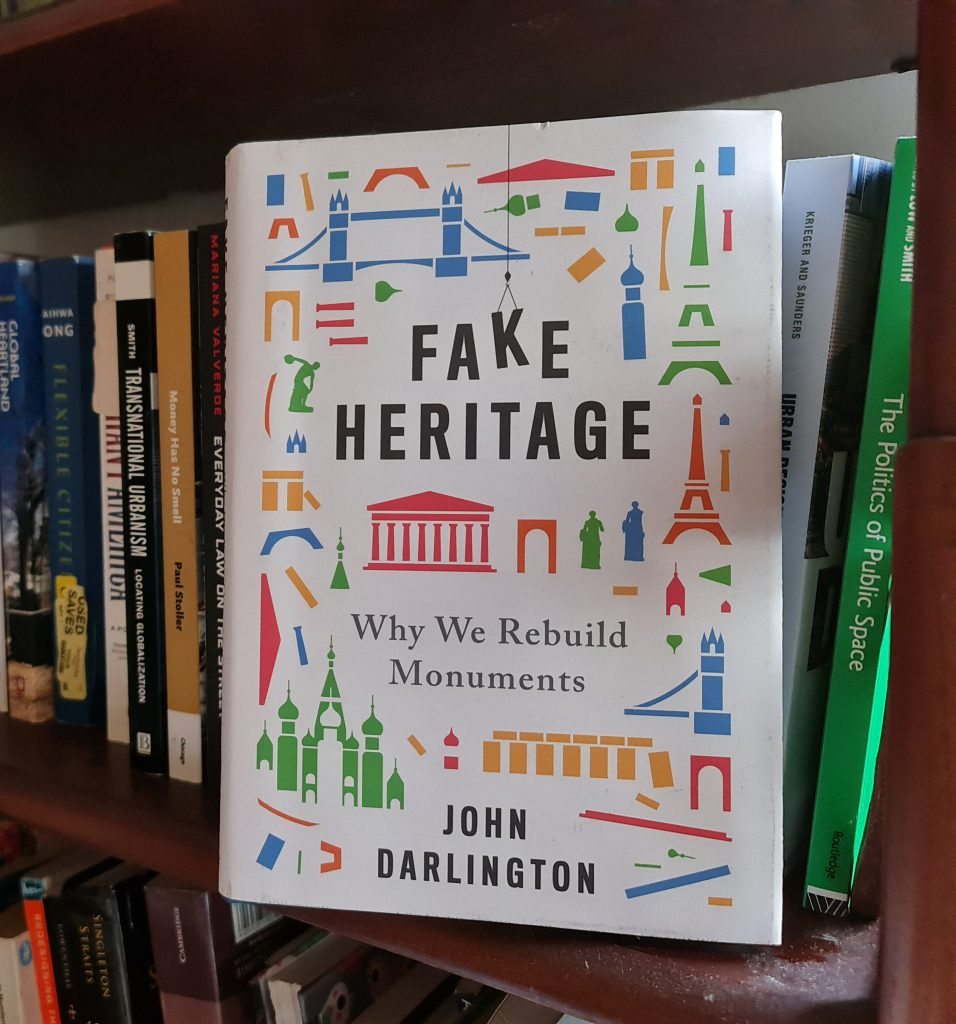Societies have long replicated, imitated, or even invented a past that never existed through built forms. From the copies of Greek temples that became popular across the Roman empire, to the themed residential neighborhoods that continue to transform cities around the world, re-producing a space from another time has helped people to construct a sense of place throughout the centuries. This phenomenon has received scholarly attention. But no one ever attempted to comprehensively map replicas of historic architectures across different regions and ages.

John Darlington accomplishes this challenging task with irony and grace. Across 247 pages, Fake Heritage seeks to answer one question: why do people physically reconstruct the past? (The sub-title of the book refers to monuments, but the volume treats a wider range of historical artefacts.) Darlington provides eight reasons why people reproduce heritage. Each reason is given a chapter, with examples spanning across different periods and geographies. Motivations for fabricating heritage become more sophisticated as the book unfolds. Darlington begins with classic forgeries made by their authors with the intention of deceiving people and acquiring fame. But the author quickly moves to clarify that replicas can be more than just cheating “fakes”. The second chapter deals with creative homages to the past, where artists unapologetically borrow from history. The book then continues with replicas built for educational and entertainment purposes, and with copies that are supposed to give prestige and political validity to their patrons. There are then built forms that are themed to brand a place, and those that leverage religious faiths to attract — and control — believers. Reconstructions after human or natural disasters are a seventh type of fake heritage, which leads us to the last one: replicas made to preserve the original.
replicas can be more than just cheating “fakes”
Darlington’s diverse cases may at first seem hazardously juxtaposed. Yet each complements one another, adding nuance to a topic that elides simplification. Some examples are classics of the literature on fake heritage. We are presented, for example, with the Japanese Ise Jingū shrines that get dismantled and reconstructed every year (and which are considered authentic precisely because of this process), and with the postwar reconstruction of Warsaw, listed by UNESCO by reason of its very fakeness. But the book also contains many other, lesser known examples. We read about the faux facades built in the mid-nineteenth century to hide new transportation infrastructures from the streetscapes of New York, Paris, and London. We are told the story of an Irish man from the mid-eighteenth century who built a ruined castle, renamed the “Jealous Wall”, facing his rival brother’s estate. And we are shown the case of central Frankfurt, where a whole neighborhood destroyed during WWII was replaced with modern-looking buildings in the 1970s, only to be re-destroyed and re-built as a historic replica in the 2000s. An incredibly rich repertoire of full-colour images complements the text. Alternating in a vibrant rhythm, words and images amplify each other, providing an immersive tour of fake heritage.
No book can exhaust all aspects of a topic. But I found some omissions of Fake Heritage more troublesome than others. For one, I found curious the lack of discussion (or at least acknowledgement) of the existing, rich scholarship on authenticity. As this very website demonstrates, scholars of heritage have taken replicas seriously for a long time. They have interrogated the meanings of copies, prompting in-depth explorations into how people construct the past by negotiating ideas of what is “real” versus “fake.” There is no mention of such debates in Fake Heritage. On the contrary, the book is built on a rather clear-cut premise: “what happens”, Darlington asks in the introduction, “when the past—or more specifically heritage—is fabricated”? His answer: “Authenticity and truths are lost”. This sentence reveals multiple assumptions that researchers of critical heritage would find uncomfortable. For me (and for many other, much more prominent scholars), heritage is always fabricated. And equating authenticity with truth is problematic for several reasons, discussing which elude my scope here. Darlington may not agree with critical interpretations of authenticity. Yet given the extensiveness of his investigation, acknowledging those interpretations would have further enriched his interesting collection.
heritage is always fabricated … equating authenticity with truth is problematic
I would have also appreciated more analyses about the exclusionary implications of fake heritage. In a book seeking reasons why societies reconstruct the past, the desires to attract capital and control people could have been given more systematic attention. As replicas of historic landmarks continue to be erected around the world, who gets to access and enjoy them, and who does not? Who profits from fake heritage, at what social costs? There are passing mentions of how replicas impinge on the lives of different city dwellers. Analyzing Saddam Hussein’s reconstruction of Babylon, for example, Darlington tells us that most landmarks were built by Sudanese laborers. As we read about the “King David” preservation project of Jerusalem, we are informed that most Arab residents are displaced from the area, and that their past is made invisible in the regenerated neighborhood. Apart from these sporadic indications, however, the book never pauses to link fake heritage to broader dynamics of urban inequality and exclusion. Not every scholar needs to center their work around questions of justice. Yet, for a book detailing so many cases, suspending judgments on power and oppression in (fake) heritage-making seems questionable.
Fake Heritage is a vibrant, unprecedently seen “compendium of falsehood” (p.223). Through its collection of text and images, the book provides a compelling picture that complicates easy dismissals of “fake heritage” as always pejorative versions of the “real thing”. As the quest for authentic experiences continues to move people and money around the world, Fake Heritage provides an excellent repertoire for scholars to delve into the social, and political ramifications of replicas.
Dr Francesca Piazzoni | Lecturer | Architecture | University of Liverpool
